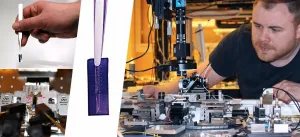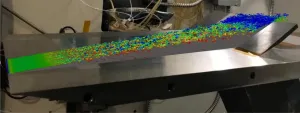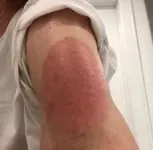(Press-News.org) Tiny photonic devices could be used to find new exoplanets, monitor our health, and make the internet more energy efficient. Researchers from Chalmers University of Technology, Sweden, now present a game changing microcomb that could bring advanced applications closer to reality.
A microcomb is a photonic device capable of generating a myriad of optical frequencies - colours - on a tiny cavity known as microresonator. These colours are uniformly distributed so the microcomb behaves like a 'ruler made of light'. The device can be used to measure or generate frequencies with extreme precision.
In a recent article in the journal Nature Photonics, eight Chalmers researchers describe a new kind of microcomb on a chip, based on two microresonators. The new microcomb is a coherent, tunable and reproducible device with up to ten times higher net conversion efficiency than the current state of the art.
"The reason why the results are important is that they represent a unique combination of characteristics, in terms of efficiency, low-power operation, and control, that are unprecedented in the field," says Óskar Bjarki Helgason, a PhD student at the Department of Microtechnology and Nanoscience at Chalmers, and first author of the new article.
The Chalmers researchers are not the first to demonstrate a microcomb on a chip, but they have developed a method that overcomes several well-known limitations in the field. The key factor is the use of two optical cavities - microresonators - instead of one. This arrangement results in the unique physical characteristics.
Placed on a chip, the newly developed microcomb is so small that it would fit on the end of a human hair. The gaps between the teeth of the comb are very wide, which opens great opportunities for both researchers and engineers.
A wide range of potential applications
Since almost any measurement can be linked to frequency, the microcombs offer a wide range of potential applications. They could, for example, radically decrease the power consumption in optical communication systems, with tens of lasers being replaced by a single chip-scale microcomb in data centre interconnects. They could also be used in lidar for autonomous driving vehicles, for measuring distances.
Another exciting area where microcombs could be utilised is for the calibration of the spectrographs used in astronomical observatories devoted to the discovery of Earth-like exoplanets.
Extremely accurate optical clocks and health-monitoring apps for our mobile phones are further possibilities. By analysing the composition of our exhaled air, one could potentially diagnose diseases at earlier stages.
Providing answers to questions not yet asked
"For the technology to be practical and find its use outside the lab, we need to co-integrate additional elements with the microresonators, such as lasers, modulators and control electronics. This is a huge challenge, that requires maybe 5-10 years and an investment in engineering research. But I am convinced that it will happen," says Victor Torres Company, who leads the research project at Chalmers. He continues:
"The most interesting advances and applications are the ones that we have not even conceived of yet. This will likely be enabled by the possibility of having multiple microcombs on the same chip. What could we achieve with tens of microcombs that we cannot do with one?"
INFORMATION:
Read the article Dissipative solitons in photonic molecules in Nature Photonics
The paper is written by Óskar B. Helgason, Francisco R. Arteaga-Sierra, Zhichao Ye, Krishna Twayana, Peter A. Andrekson, Magnus Karlsson, Jochen Schröder and Victor Torres Company at the Department of Microtechnology and Nanoscience at Chalmers.
All the research, including modelling, theoretical and experimental work and nanofabrication, has been carried out at Chalmers University of Technology.
The research has been funded by the European Research Council, through Victor Torres Company's ERC Consolidator Grant, and by the Swedish Research Council.
More about: Frequency combs and microcombs
A frequency comb is a special laser where the emission frequencies are evenly spaced. It functions as a ruler made of light, where the markers set the frequency scale across a portion of the electromagnetic spectrum, from the ultraviolet to the mid infrared. The location of the markers can be linked to a known reference. This was achieved in the late 90s, and it signified a revolution in precision metrology - an achievement recognised by the Nobel Prize in Physics in 2005.
A microcomb is a modern technology, alternative to mode-locked lasers, that can generate repetitive pulses of light at astonishing rates. They are generated by sending laser light to a tiny optical cavity called a microresonator. Thus, microcombs have two important attributes that make them extremely attractive for practical purposes: the frequency spacing between markers is very large (typically between 10 - 1,000 GHz), that is much higher than the spacing in mode-locked laser frequency combs, and they can be implemented with photonic integration technology. The compatibility with photonic integration brings benefits in terms of reduction of size, power consumption and the possibility to reach mass-market applications. The large spacing between teeth means that microcombs can be used for novel applications, such as light sources for fiber-optic communication systems or for the synthesis of pure microwave electromagnetic radiation.
The key to the new enhanced microcomb from Chalmers is that the researchers have used two microresonators instead of one. The microresonators interact with each other, similar to how atoms bind together when forming a diatomic molecule. This arrangement is known as a photonic molecule and has unique physical characteristics.
Using data collected in a NASA Langley Mach 6 wind tunnel, researchers at the University of Illinois Urbana-Champaign replicated the hypersonic flow conditions of a compression ramp flow by means of Direct Numerical Simulation. The simulation yielded an abundance of additional data, which can be used to better understand the phenomena that occur surrounding vehicles traveling at hypersonic speeds.
"Data from experiments are somewhat limited--for example taken from pressure probes at a few locations on a test object. When we run a numerical simulation, we acquire information - such as pressure, temperature, ...
A rapid microbiological point-of-care test to diagnose respiratory infections has proved popular with GPs and could reduce antibiotic prescribing in primary care, according to a National Institute for Health Research funded study by researchers at the Centre for Academic Primary Care, University of Bristol.
There are high rates of antibiotic prescribing in primary care and the UK government has called for the introduction of rapid diagnostics to curb overuse.
The RAPID-TEST study, published in the journal Family Practice today [4 March] evaluated ...
Scientists at the Francis Crick Institute and UCL have identified the trigger of a key cellular change in amyotrophic lateral sclerosis (ALS), a type of motor neurone disease. The findings could help develop new treatments for many neurological diseases with the same change, including Parkinson's and Alzheimer's.
When the nervous system is injured, diseased or infected, star-shaped cells, called astrocytes, undergo 'reactive' changes in their behaviour. Whilst some of these reactive astrocytes become protective, others become harmful and damage surrounding motor neurons.
Reactive astrocytes are observed in various neurodegenerative diseases including ALS, but there is a lack of understanding about what causes astrocytes to ...
The Wellcome Trust, one of the world's top funders of health research, stands to gain financially from the covid-19 pandemic, raising questions about transparency and accountability, reports The BMJ today.
Independent journalist Tim Schwab shows how the charity plays a leading role in a WHO programme to support new covid-19 therapeutics, while holding investments in companies producing these same treatments.
It follows news reports that another charity, the Gates Foundation, is also positioned to potentially benefit financially from its leading role in the pandemic response.
Financial disclosures from late 2020 show that Wellcome has a £275m stake in Novartis, which manufactures dexamethasone, and a £252m ...
More than three quarters (78%) of hospitals surveyed between June and August 2020 reported that their paediatric cancer care had been affected by the pandemic.
Almost half (43%) made fewer new cancer diagnoses than expected, while around one third (34%) noted a rise in the number of patients abandoning treatment.
Nearly one in ten (7%) closed their paediatric cancer units completely at some stage during the pandemic.
Hospitals in low- and middle-income countries (LMICs) were disproportionately affected, with unavailability of chemotherapy, treatment abandonment, and disrupted radiotherapy among issues more frequently reported.
The COVID-19 pandemic has had major impacts on childhood cancer care worldwide, ...
Daily infusions of albumin provide no significant health benefit to patients hospitalised with advanced liver disease, over and above 'standard care', finds a large-scale multicentre trial led by UCL researchers.
Albumin is a protein made in the liver that prevents fluid leaking from the bloodstream to other body tissues and carries various substances throughout the body, such as hormones or enzymes. In people with liver disease, low albumin levels are associated with an increased risk of death among hospitalised patients who have cirrhosis, and laboratory studies have shown albumin to have an anti-inflammatory effect. Therefore, albumin infusions are considered the best fluid for patients with cirrhosis and are an integral part of clinical care.
Explaining the ATTIRE* trial, Principal ...
BOSTON - As the speed and scale of vaccinations against the SARS-CoV-2 virus ramps up globally, researchers at Massachusetts General Hospital (MGH) are calling for greater awareness and communication around a delayed injection-site reaction that can occur in some patients who have received the Moderna mRNA-1273 vaccine.
In a letter to the editor published online in The New England Journal of Medicine (NEJM), the authors note Phase 3 clinical data from the Moderna vaccine trial did show delayed skin hypersensitivity in a small number of the more than 30,000 trial participants. However, the authors say the large, red, sometimes raised, itchy or painful skin reactions were never fully characterized ...
Scientists say outdated assumptions around gender continue to hinder effective and fair policymaking and action for climate mitigation and adaptation.
Lead author of a new study, Dr Jacqueline Lau from the ARC Centre of Excellence for Coral Reef Studies at James Cook University (Coral CoE at JCU) and WorldFish, said gender--alongside other identities like race, class and age--has a powerful influence on people's experience of, and resilience to, climate change.
She said the four most common and interlinked assumptions found are: women are innately caring and connected to the environment; women are a homogenous and vulnerable group; gender equality is a women's issue and; gender equality ...
ITHACA, N.Y. - How might people's political ideology affect their perception of race?
Previous research by Amy Krosch, assistant professor of psychology in the College of Arts and Sciences, has shown that white people who identify themselves as political conservatives tend to have a lower threshold for seeing mixed-race Black and white faces as Black.
More often than liberals, Krosch found, white political conservatives show a form of social discrimination termed "hypodescent" - categorizing multiracial individuals as members of the "socially subordinate" racial group.
In new research published Feb. 22 in Philosophical Transactions of Royal Society B, Krosch used neuroimaging to show that this effect seems to be driven by white ...
As COVID-19 lockdowns and quarantines are lifted, businesses are now faced with the challenge of how to keep their employees who are returning to work motivated and engaged.
A study led by a University of Illinois Chicago researcher shows that both employees and managers have an important part to play in promoting employee engagement during the pandemic.
The research, published in the Journal of Applied Psychology, suggests employee engagement and performance are the highest when employees are mentally prepared for their return to work and their managers are strongly committed to employees' health and safety at work.
"Given the turmoil and distress during lockdowns ...



